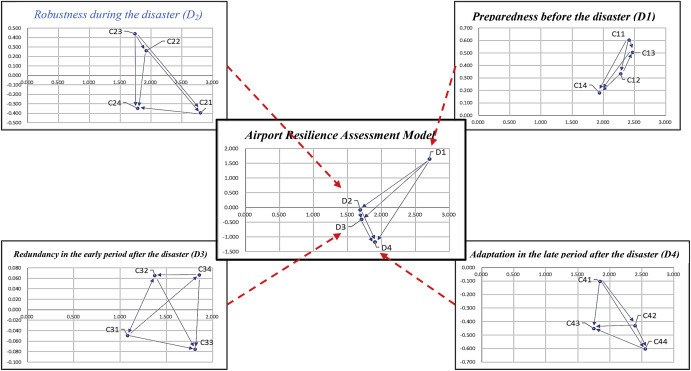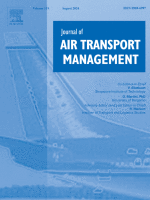Developing an airport resilience assessment model for climate change
The model helps airports assess resilience comprehensively across disaster stages. It enables prioritization of critical areas like evacuation plans and rapid repairs. Recommendations support tailored improvements in staff training and backup systems. It supports proactive, data-driven resourcing and aligns with audit results. Ultimately, it enhances airport safety, reduces disruptions, and boosts resilience.

Fig. 3. Influential Network Relation Map (INRM) of the factors influencing airport resilience.
Technology Overview
A hybrid model of airport resilience assessment for climate change. The model combines modified DEMATEL and VIKOR methods. Dombi Weighted Aggregator method is applied to integrate various opinions. An empirical example of Taiwan airports is used to demonstrate the model. Some management implications are provided.
Applications & Benefits
This hybrid multi-assessment model enables airport authorities to evaluate and prioritize disaster resilience across different response stages, pinpointing critical areas such as pre-disaster preparedness, emergency procedures, and rapid repair mechanisms. It supports data-driven decision-making, allowing resource allocation based on interdependent criteria and expert input rather than isolated indicators. The framework facilitates the identification of urgent and essential improvements, such as staff training, backup systems, and external support agreements, enhancing both readiness and recovery. By tailoring recommendations to individual airports, the model provides actionable guidance aligned with long-term audit findings. This approach helps airports in minimizing service disruptions, improving safety, and strengthening resilience against a variety of hazards.
Abstract:
Climate change is affecting the stability of all types of transportation systems, including air transport. Ensuring the disaster preparedness capability of an airport has become a crucial issue. Prior studies on assessing airport resilience and risk analysis have failed to consider the impact of the disaster at various stages and the interdependence between the factors or criteria. This study proposes airport resilience model that considers the various stages of disaster response. First, we collect criteria affecting airport resilience through literature review and experts' survey to develop a novel evaluation framework. Second, this study applies the modified DEMATEL (Decision Making Trial and Evaluation Laboratory) which was modified by introducing the concept of heterogeneous impact analysis and combined with the concept of centrality weighting. Then, the modified DEMATEL is further combined with the Dombi Weighted Aggregator method to explore the interdependence relationships among the criteria and effectively integrate expert opinions. Finally, modified VIKOR (VlseKriterijumska Optimizacija I Kompromisno Resenje) analysis is applied to assess the resilience performance of Taiwan's major international airports and provide suggestions for improvement. The results indicate that pre-disaster preparation, with a weight of 0.338 among four stages, is the most crucial stage for enhancing airport resilience. This can be achieved through the implementation of effective emergency response procedures and evacuation plans in the event of a disaster. Additionally, this study suggests various improvement strategies based on the assessment results to enhance disaster resistance and resilience.

Developing an airport resilience assessment model for climate change
Author:Chao-Che Hsu, Hsiang-Chuan Chang, Yan-Cheng Li, James J.H. Liou
Year:2024
Source publication:Journal of Air Transport Management, Volume 119, August 2024
Subfield Highest percentage:98% Law #16 / 1105
https://www.sciencedirect.com/science/article/pii/S096969972400111X
